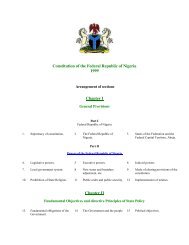Economic Recovery Growth Plan (ERGP) 2017-2020
This Medium Term Plan of the Federal Republic of Nigeria was designed to tackle the huge decline in the country’s economy since her shift from agriculture sector to crude oil and gas sector in the late 1960s. The plan’s objective includes restoring growth, investing in citizens and building a globally competitive economy.
This Medium Term Plan of the Federal Republic of Nigeria was designed to tackle the huge decline in the country’s economy since her shift from agriculture sector to crude oil and gas sector in the late 1960s. The plan’s objective includes restoring growth, investing in citizens and building a globally competitive economy.
You also want an ePaper? Increase the reach of your titles
YUMPU automatically turns print PDFs into web optimized ePapers that Google loves.
This <strong>Plan</strong> provides details of the current economic situation that underscore the scale of the challenge and<br />
the urgency of the actions required. It lays out stable and coherent macroeconomic policies to restore<br />
Nigeria to growth, and outlines the sectors that the Federal Government will prioritize because of their<br />
potential to drive growth and contribute to GDP growth, their ability to respond strongly to stimulus, the<br />
flexibility of their production methods and their capacity to innovate and generate large-scale<br />
employment.<br />
First-class infrastructure and an economic environment that supports the private sector and enables it to<br />
expand, take risk and employ people are essential to achieve Nigeria’s aspirations for a dynamic,<br />
competitive economy. The <strong>ERGP</strong>’s proposed strategies include improving the national infrastructure<br />
backbone (power, roads, railways, airports and seaports) and reducing the transaction cost of doing<br />
business by streamlining processes and speed of delivery in the regulatory environment. The <strong>ERGP</strong> lays<br />
out programmes and policies to achieve the Federal Government’s objective of reducing poverty and<br />
enabling all areas of society to benefit from available economic opportunities. This requires a healthy,<br />
educated citizenry able to establish businesses that create jobs, a hardworking and productive workforce,<br />
and Government policies to tackle poverty, hunger and inequality.<br />
Finally, the <strong>Plan</strong> articulates how the Federal Government will combat corruption, promote good<br />
governance, ensure security and reform the public service, and deliver, monitor, evaluate and<br />
communicate the progress against the plan.<br />
1.1 RATIONALE FOR THE ECONOMIC RECOVERY AND GROWTH PLAN<br />
After more than a decade of steady progress, economic growth has slowed because of both external and<br />
internal challenges. Externally, the global economy has remained fragile and flat since the onset of the<br />
global financial and economic crisis in 2008. With the slowing of growth in China, commodity prices have<br />
declined sharply with oil prices plummeting from as high as USD114 per barrel to as low as USD28 per<br />
barrel between 2014 and 2016. This has had a severe negative impact on the growth rate of Nigeria’s<br />
economy, which recovered slightly immediately after the global crisis but fell back sharply again in<br />
tandem with crude oil prices (Figure 1.1).<br />
Figure 1.1: Real GDP <strong>Growth</strong> Rate, 2005-2016<br />
22





